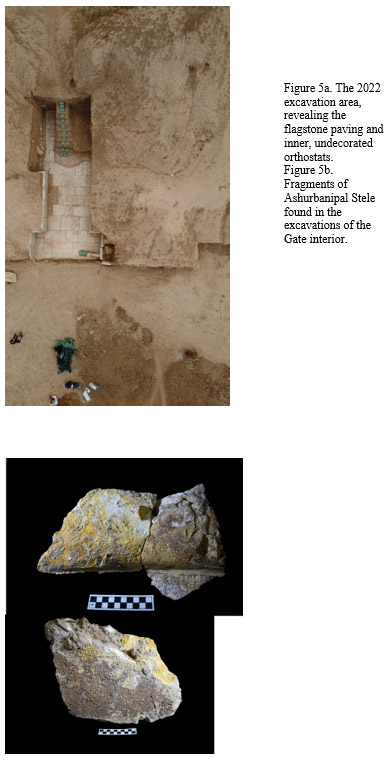The Shamash Gate Project
This past October, a team led by Dr. Tim Harrison returned to continue their work at the ancient site of Nineveh within the city of Mosul, Iraq.

The Shamash Gate Project, focuses on the clearing and conserving of the Shamash Gate – the largest and most elaborate of the fifteen gates of the ancient Assyrian capital city. Named after the Sun god Shamash, this impressive structure is constructed of mudbrick and stone, and faced with carved limestone blocks, crowned by crenelations all along its top. The Gate controls the main road to the east which would have led to the important city of Arbela, modern Erbil. The gate had originally been explored by Henry Layard in the 1840s but was more thoroughly cleared out and reconstructed by Iraqi archaeologists in the 1960s. Following years of neglect and then heavily damaged by tunneling by Islamic State forces during their occupation of the city between 2014-17 the gate fell into a critical state in need of significant attention. Prof. Nicolo Marchetti of the University of Bologna director of the East Nineveh Project, and a CRANE Project member, invited Harrison in 2020 to evaluate the gate and develop a mitigation program.
In 2021, the first season of the Shamash Gate Project, a team from Toronto went to Mosul to map the damage done to the monument by ISIS, and undertake some clearing and small-scale excavations.

Utilizing a laser scanner borrowed from CRANE members at the University of British Columbia (Fig. 2), the 200m of tunnels torn into the monument by ISIS fighters were mapped. Clearing off the face of the monument revealed the preservation of much of the remains first identified in the 1960s excavations. That same year, the SBAH and the Mosul municipality requested our assistance in preserving/ incorporating the gate into a public community park.

During the winter of 2021-22, with help from the Canadian embassy in Baghdad, Dr. Harrison made contact with the United Nations Development Program (UNDP) whose team of engineers went and investigated the tunnels. Identifying the urgency of the situation, the UNDP obtained funding for and filled in the tunnels dug into the Shamash Gate at an incredible pace, achieving one of the major goals of the project (Fig. 3).

In 2022, the team returned to conduct further work, with the aim of starting to clear the interior of the Gate. Excavations of other gates in the past, such as the Halzi Gate (by Berkeley in 1989-90), revealed spectacular remains of a destruction dated to the 612 BC sacking of Nineveh by the Medes and the Babylonians. However, since the Shamash Gate had originally been investigated by the Iraqis in the 1960s, no dramatic discoveries were anticipated. The 2022 season saw the excavation of the first 15m of the west end of the Gate. While the depth of infill ranged between 40cm and 3m, what rapidly emerged was a number of surprises. The primary surprise was that the Iraqi team from nearly sixty years earlier never reached the original surfaces, particularly those from the first construction of the Gate. The original stone paved surface was cleared in most of the 15m, and the entrance to the two side chambers were identified. About 30cm above the original stone paving, a secondary pebble stone surface had been laid down throughout the gate, upon which significant debris began to emerge. Buried in the mudbrick and rock tumble were many large fragments of a carved and inscribed Neo-Assyrian stele. While the complete stele has yet to be excavated, preliminary readings reveal it to be a stele written by the Assyrian King Ashurbanipal (669-631 BC), the first stele found attributed to this king. Also found within the debris were poorly preserved and disarticulated human remains. It would appear that both the stele and the deceased were probably dated to the 612 BC sacking of the city, but at the time of the destruction were in a different location, perhaps originally located in one of the side chambers Long after the abandonment of the Gate they had washed or eroded into the center where they were found. Work will continue in 2023 to continue the clearing of the gate and perhaps one of the side chambers, hopefully finding the remainder of the stele fragments so they can properly be reconstructed and put on display. This first 15m that was excavated in the 2022 season represents approximately only 25% of the gateway central interior pathway. The identification of intact remains dated to the 612BC destruction of the city in this short season suggests that many more spectacular discoveries lay in store for the NMC team in future seasons at the Shamash Gate.

